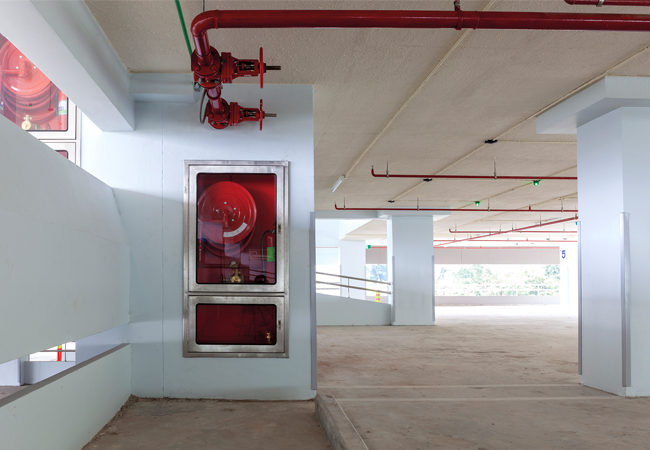
Credit: iStock hxdyl
Dame Judith’s review revealed a widespread lack of understanding about what information is required under Regulation 38. This lack of understanding led many in the building control profession to consider that the drafting of the requirement made it unenforceable.
The low level of penalties for non-compliance coupled with the costs to a local authority to take enforcement action meant that they did not take such action. The review found no evidence of any enforcement action for failure to provide fire safety information about a completed building.
Parts 8 and 9 of the amended regulations seek to address these deficiencies in the provision of information about buildings and about the testing and commissioning that is required to be undertaken prior to handover.
Regulation 38 spells out how fire safety information is to be provided on ‘any’ building when work is completed. And it creates new duties for both the person having the work done and the person doing the work to provide and acknowledge provision of the information. And to avoid confusion, this is not just for higher risk buildings, it’s for all building projects, as indeed it always has been.
The new amended Regulation 38 is five times longer and now spells out in detail the information to be provided under Regulation 38. That is the duty of the person carrying out the work and it must be provided by the date of occupation or completion, whichever is earlier. It seems reasonable to require this information to be provided before the building is occupied: which reader wants to be in any building for which the owner or operator has not got that information?
Regulation 38 spells out how fire safety information is to be provided on ‘any’ building when work is completed
The amended regulation also requires the person responsible for having the work done to acknowledge receipt of the information and confirm that it is sufficient for them to understand the fire safety provisions in the building. That is a key step, as it removes any defence that ‘oh, we never got that information!’ or ‘we never understood any of the stuff in those ring binders’.
And to round off, the person doing the work has to confirm to the relevant authority that they have given the information and that it has been received and acknowledged. Self certification schemes have 30 days to do this, everyone else has five days. Note that this time limit applies to the confirmation, not the original provision of the information.
Given the prominence which the regulation gained during the Review and subsequent focus on fire safety information, it seems reasonable to anticipate that building control bodies (who will be registered with and overseen by the new Regulator) will take compliance with Regulation 38 more seriously. And the way that the Regulation is drafted, failure by the person doing the work to notify building control will constitute a breach of the regulation. And grounds not to certify completion of the whole works. And this is not for higher risk buildings, but for all projects.
The requirement for the responsible person to accept the report also guards against claiming to have provided the information without really meeting the intent. So be prepared – regulation 38 is now simple to enforce and needs to be complied with.
Part 9 of the Building Regulations covers testing and commissioning and has been amended to take account of the new Regulator for HRBs. In the case of Regulation 44, commissioning, there may be a heightened focus on the commissioning of ventilation systems, especially where they play a role in the fire strategy by, for example, acting as a smoke ventilation system. In this case the commissioning of the ventilation system, including associated controls, is fundamental to demonstrating that the fire safety systems work effectively. So there is likely to be a greater focus on commissioning under the new regime, especially in HRBs.
Parts 8 and 9 of the amended regulations seek to address these deficiencies in the provision of information about buildings and about the testing and commissioning that is required to be undertaken prior to handover
Commissioning also links to the fire safety information. Without a fully functioning ventilation system or water system the fire strategy may simply not work. So there is likely to be a new emphasis on these requirements.
This does not require building control bodies suddenly to become M&E experts. The regulations require those undertaking the work to provide the information. So the key test for the building control body is whether that work has been done and the information provided. It needs limited building services expertise to check that these things have been done.
And with the new duties on designers and contractors to cooperate, it may become more challenging to try to fudge the commissioning without someone raising a concern. After all, a ventilation system that doesn’t work cannot ventilate smoke in a fire and might be considered a significant risk to life. In a higher risk building that would be a mandatory occurrence that all parties have a duty to report.
There is also a new set of regulations introduced into Part 10 setting out new compliance and enforcement provisions. So the old Regulation 47, which disallowed enforcement of various regulations, has been thoroughly overhauled. It now only disallows certain very specific paragraphs of those regulations, largely procedural aspects, and only to the extent that enforcement action cannot be taken against the regulator in respect of those processes.
A ventilation system that doesn’t work cannot ventilate smoke in a fire and might be considered a significant risk to life. In a higher risk building that would be a mandatory occurrence that all parties have a duty to report
So, for example, where the BSR fails to send copies of an energy certificate to the local authority, (Regulation 27A ((4A) they cannot be subject to enforcement action under the Building Act, although they may be subject to other remedies for not doing what they are required to do. But the rest of the Regulation on fabric energy efficiency certainly can be enforced.
None of these amendments change the technical requirements of the Regulations. They merely require what has been done to be recorded and reported with rigour. For those who already do what is required this will not be a huge challenge. For those who have perhaps not been fully compliant then they may pose more of a challenge.
Bodies such as CIBSE will be working together with the Construction Leadership Council and Its constituent bodies to provide further industry guidance on these regulations and on how clients, principal designers and contractors, and Accountable Persons can meet the new obligations in a safe, reasonable and proportionate manner. It is another step on the road to rebuilding trust in the construction and operation of our higher rise building stock, and another step on the road to building a safer future.
- CIBSE will be setting out the breadth of regulatory changes and new requirements of the building regulations at the one day conference: Building Safety: Meeting the Building regulations and delivering the Golden Thread on 28 September, London. For more information and to book visit CIBSE Golden Thread series.
ABOUT THE AUTHOR
Dr Hywel Davies is a former chair of the Building Regulations Advisory Committee who has worked in the field of regulations and standards for over 35 years. He is chief technical officer of the Chartered Institution of Building Services Engineers and an Honorary Fellow of CIBSE.
Links to new regulations
The new regulations deliver the recommendations of Dame Judith Hackitt in her report Building A Safer Future and cover the technical detail underpinning the new, more stringent regime for the design and construction of higher-risk buildings, wider changes to the Building Regulations for all buildings and the details of the new in-occupation safety regime for higher-risk buildings.
Amendments announced on August 17 2023:
The Building Regulations etc. (Amendment) (England) Regulations 2023
The Building Regulations (Higher-Risk Building Procedures) (England) 2023
The Building (Approved Inspectors etc. And Review of Decisions) (England) Regulations 2023
The Higher-Risk Buildings (Management of Safety Risks etc) (England) Regulations 2023
The Building Safety Act 2022 (Consequential Amendments etc.) Regulations 2023
A summary of all secondary legislation can be found at:
The Building Safety Act: secondary legislation






